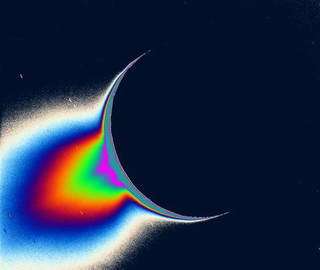Cassini images reveal spectacular evidence of an active moon

Jets of fine, icy particles streaming from Saturn's moon Enceladus were captured in recent images from NASA's Cassini spacecraft. The images provide unambiguous visual evidence the moon is geologically active.
Image: Recent Cassini images of Saturn's moon Enceladus backlit by the sun show the fountain-like sources of the fine spray of material that towers over the south polar region.
"For planetary explorers like us, there is little that can compare to the sighting of activity on another solar system body," said Dr. Carolyn Porco, Cassini imaging team leader at the Space Science Institute in Boulder, Colo. "This has been a heart-stopper, and surely one of our most thrilling results."
The Cassini images clearly show multiple jets emanating from the moon's south polar region. Based on earlier data, scientists strongly suspected these jets arise from warm fractures in the region. The fractures, informally dubbed "tiger stripes," are viewed essentially broadside in the new images.
The fainter, extended plume stretches at least 500 kilometers (300 miles) above the surface of Enceladus, which is only 500 kilometers wide. Cassini flew through the plume in July, when it passed a few hundred kilometers above the moon. During that flyby, Cassini's instruments measured the plume's constituent water vapor and icy particles.
Imaging team members analyzed images of Enceladus taken earlier this year at similar viewing angles. It was a rigorous effort to demonstrate that earlier apparitions of the plumes, seen as far back as January, were in fact real and not due to imperfections in the camera.
The recent images were part of a sequence planned to confirm the presence of the plumes and examine them in finer detail. Imaging team member Dr. Andrew Ingersoll from the California Institute of Technology in Pasadena, said, "I think what we're seeing are ice particles in jets of water vapor that emanate from pressurized vents. To form the particles and carry them aloft, the vapor must have a certain density, and that implies surprisingly warm temperatures for a cold body like Enceladus."
Imaging scientists are comparing the new images to earlier Cassini data in hopes of arriving at a more detailed, three-dimensional picture of the plumes and understanding how activity has come about on such a small moon. They are not sure about the precise cause of the moon's unexpected geologic vitality.
"In some ways, Enceladus resembles a huge comet," said Dr. Torrence Johnson, imaging team member from NASA's Jet Propulsion Laboratory (JPL) in Pasadena. "Only, in the case of Enceladus, the energy source for the geyser-like activity is believed to be due to internal heating by perhaps radioactivity and tides rather than the sunlight which causes cometary jets." The new data also give yet another indication of how Enceladus keeps supplying material to Saturn's gossamer E ring.
The latest images, including a time sequence showing the plumes, can be found at ciclops.org .
Source: Space Science Institute

















